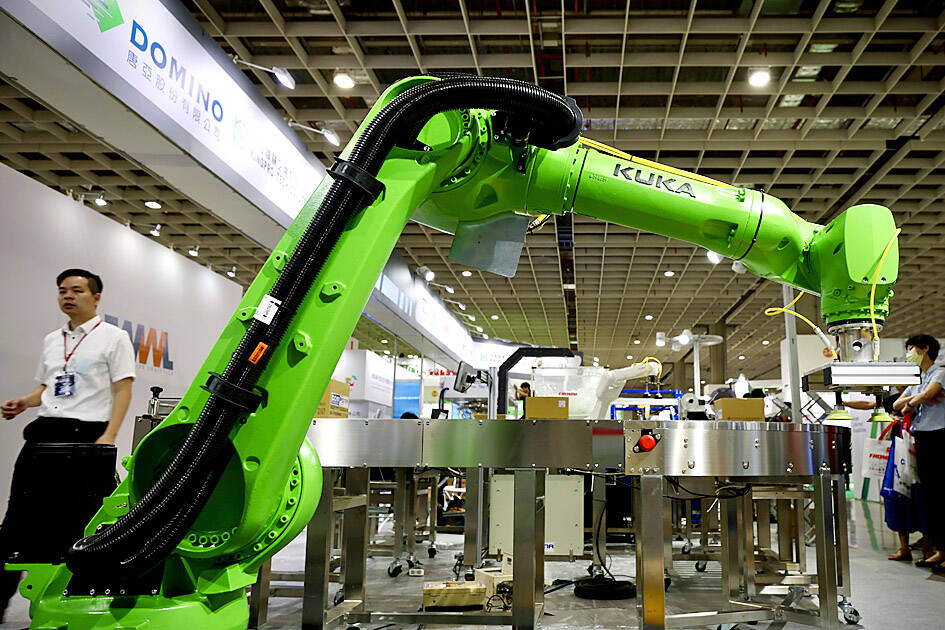The nation’s machinery exports last month fell 3.8 percent year-on-year, dropping for a 17th straight month as the local manufacturers struggled with macroeconomic headwinds and unfavorable foreign exchange rates, the Taiwan Association of Machinery Industry said in a report yesterday.
Machinery exports — comprising inspection and testing of equipment, electronic equipment and machine tools — totaled US$2.62 billion (US$84.14 million) last month, down from US$2.72 billion a year earlier, but up from US$2.49 billion the previous month, data compiled by the association showed.
The annual decrease in machinery exports continued to shrink over the past two months, suggesting a positive growth in overall shipments is around the corner for the industry, the report said.

Photo: Ritchie B. Tongo, EPA-EFE
However, exports of machine tools last month registered negative growth for the 11th consecutive month with an annual decrease of 19.8 percent, an indication that makers of machine tools remained victims of geopolitical tensions, macroeconomic weakness and the sharp depreciation of the Japanese yen, it said.
As global competition for orders becomes increasingly fierce, foreign exchange rates have become a key factor affecting Taiwanese manufacturers’ ability to secure orders, the association said, adding that the government should keep a close eye on the exchange rates of rival nations.
The NT dollar last year depreciated 1.03 percent against the US dollar, while the won declined 4.22 percent, the yuan 3.51 percent and the yen 10.33 percent, it said.
For the whole of last year, machinery exports slid 15.3 percent year-on-year to US$29.47 billion, the report said.
Production value in the machinery industry also decreased 16.5 percent to NT$1.21 trillion from the previous year, it said.
By product, exports of machine tools last year fell 14 percent from a year earlier to US$2.3 billion, overseas shipments of electronic equipment decreased 6.1 percent to US$4.76 billion and those of inspection and testing of equipment dropped 6.1 percent to US$4.61 billion, the report said.
China and the US were the two largest buyers of Taiwanese machinery last year at US$6.93 billion each, equally with a 23.5 percent share of the nation’s total exports, followed by Japan, with purchases totaling US$2.38 billion and accounting for 8.1 percent, it said.
Local machinery makers remain conservative about their business outlook this year as the overall manufacturing industry has not completely come out of the woods and firms are cautious about investing in machinery equipment, the report said.
The association said it would seek support from its Chinese counterpart to persuade Beijing from implementing new trade measures against Taiwan — such as suspending tariff concessions on several products including machinery under the Economic Cooperation Framework Agreement early harvest list — as the deal is mutually beneficial to the machinery industry on both sides of the Taiwan Strait.
Local manufacturers should make more efforts to expand their presence in other markets such as the US, Mexico and the Middle East to diversify their risk, it said.

SEMICONDUCTORS: The firm has already completed one fab, which is to begin mass producing 2-nanomater chips next year, while two others are under construction Taiwan Semiconductor Manufacturing Co (TSMC, 台積電), the world’s largest contract chipmaker, plans to begin construction of its fourth and fifth wafer fabs in Kaohsiung next year, targeting the development of high-end processes. The two facilities — P4 and P5 — are part of TSMC’s production expansion program, which aims to build five fabs in Kaohsiung. TSMC facility division vice president Arthur Chuang (莊子壽) on Thursday said that the five facilities are expected to create 8,000 jobs. To respond to the fast-changing global semiconductor industry and escalating international competition, TSMC said it has to keep growing by expanding its production footprints. The P4 and P5

DOWNFALL: The Singapore-based oil magnate Lim Oon Kuin was accused of hiding US$800 million in losses and leaving 20 banks with substantial liabilities Former tycoon Lim Oon Kuin (林恩強) has been declared bankrupt in Singapore, following the collapse of his oil trading empire. The name of the founder of Hin Leong Trading Pte Ltd (興隆貿易) and his children Lim Huey Ching (林慧清) and Lim Chee Meng (林志朋) were listed as having been issued a bankruptcy order on Dec. 19, the government gazette showed. The younger Lims were directors at the company. Leow Quek Shiong and Seah Roh Lin of BDO Advisory Pte Ltd are the trustees, according to the gazette. At its peak, Hin Leong traded a range of oil products, made lubricants and operated loading

Citigroup Inc and Bank of America Corp said they are leaving a global climate-banking group, becoming the latest Wall Street lenders to exit the coalition in the past month. In a statement, Citigroup said while it remains committed to achieving net zero emissions, it is exiting the Net-Zero Banking Alliance (NZBA). Bank of America said separately on Tuesday that it is also leaving NZBA, adding that it would continue to work with clients on reducing greenhouse gas emissions. The banks’ departure from NZBA follows Goldman Sachs Group Inc and Wells Fargo & Co. The largest US financial institutions are under increasing pressure

STIMULUS PLANS: An official said that China would increase funding from special treasury bonds and expand another program focused on key strategic sectors China is to sharply increase funding from ultra-long treasury bonds this year to spur business investment and consumer-boosting initiatives, a state planner official told a news conference yesterday, as Beijing cranks up fiscal stimulus to revitalize its faltering economy. Special treasury bonds would be used to fund large-scale equipment upgrades and consumer goods trade-ins, said Yuan Da (袁達), deputy secretary-general of the Chinese National Development and Reform Commission. “The size of ultra-long special government bond funds will be sharply increased this year to intensify and expand the implementation of the two new initiatives,” Yuan said. Under the program launched last year, consumers can